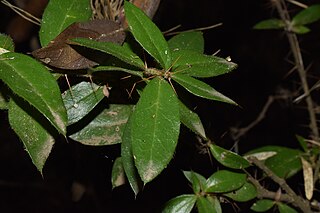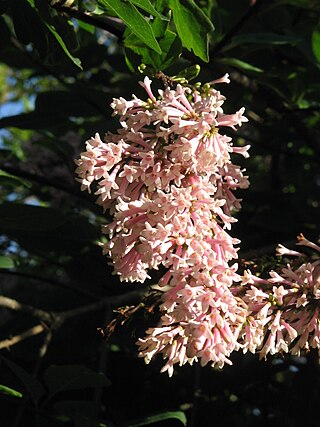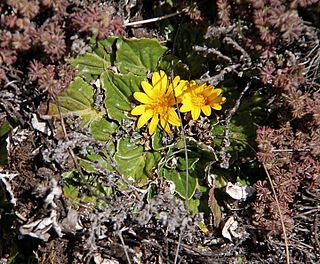
Wilhelm Peter Eduard Simon Rüppell, also spelled Rueppell was a German naturalist and explorer, best known for his collections and descriptions of plants and animals from Africa and Arabia.

Adonis is a genus of about 20–30 species of flowering plants of the crowfoot family, Ranunculaceae, native to Europe and Asia.

Pachypodium ambongense is a species of plant in the family Apocynaceae. It was first published as a species of the genus Pachypodium in 1924 by the botanist Henri Louis Poisson.
Pachypodium bicolor is a species of plant in the family Apocynaceae.

Dasyphyllum excelsum is a species of flowering plant in the family Asteraceae. This species is endemic to Chile, occurring from Quillota to Cauquenes between 190 and 800 m above sea level, a specific location of occurrence being in central Chile within the Cerro La Campana forests in association with the endangered Chilean wine palm, Jubaea chilensis.

Mylothris rueppellii, the Rüppell's dotted border or twin dotted border, is a butterfly of the family Pieridae. It is found in most of Africa, south of the Sahara. The wingspan is 48–55 millimetres (1.9–2.2 in) for males and 50–56 mm (2.0–2.2 in) for females. Adults are on wing year-round, with peaks in October and from late February to April in southern Africa. The larvae feed on various Loranthaceae species, including Loranthus, Tapinanthus oleifolius and Tapinanthus rubromarginatus.

Anoectochilus koshunensis is a species of plant in the family Orchidaceae native to Taiwan and to Nansei-shoto.
Acanthopale pubescens is a species of the genus Acanthopale of the family Acanthaceae. The species occurs in East and Southern Africa. Acanthopale pubescensis also known as Herayye in Ethiopia.

Cherangani Hills Forest is a collection of thirteen forest reserve blocks in western Kenya, located in the Cherangani Hills on the western ridge of the East African Rift. The forested area is about 1,200 square kilometres (463 sq mi), 956 square kilometres (369 sq mi) of which has been gazetted into forest reserves. These forest reserves form the upper catchments of the Kerio and Nzoia and Turkwel rivers.

Karomia speciosa is an African deciduous large shrub or bushy tree up to 7 m, and relocated to the family Lamiaceae from Verbenaceae. It is one of 9 species in the genus Karomia, a genus containing species previously classified in Holmskioldia, and is closely related to Clerodendrum. The only remaining species in the genus is Holmskioldia sanguinea, occurring in the foothills of the Himalayas.

Hymenodictyon parvifolium Oliv. is a small rubiaceous African tree and is one of some 24 species in the genus, with a tropical African and Asian distribution. This species grows as a small tree to some 5 metres tall, or sometimes a liane or scrambler to 10.5 m, and is found in low-altitude woodland.

Syringa tomentella is a species in the genus Syringa, in the family Oleaceae.

Brachylaena rotundata is an occasionally deciduous Southern African shrub or small tree growing to some 8m in height and of the family Asteraceae. It occurs in eastern Botswana, Transvaal, Mozambique, Zambia and Zimbabwe, growing in open woodland, on rocky koppies and slopes, and on stream banks. Kew accepts Brachylaena rotundata S. Moore as a species while 'Flora of Mozambique' treats it as a variety of Brachylaena discolor DC. It bears attractive foliage, green on the upper surface and silver-grey on the lower, leaves turning slightly reddish in autumn.
Leaves with petioles from 2 mm to 7 mm. long, lamina 4–15 x 2.5–6 cm., larger on coppice shoots, broadly oblanceolate or elliptic, obtuse to rounded at the apex, cuneate or rounded base, entire, occasionally coarsely dentate near the apex; upper surface araneous when young, or glabrescent; lower surface greyish tomentellous with prominent veins. Capitula sometimes preceding the leaves, young synflorescences with buds in axillary and terminal spikes, mature synflorescences with numerous capitula in dense terminal panicles 4–

Guizotia jacksonii is a low, creeping, perennial plant with ovate leaves and yellow flowerheads belonging to the family Asteraceae. This species is endemic to Kenya, and grows in along roads and other open treaded places in the forest zones the central highlands of Kenya.

Haplocarpha rueppellii is a very low to low perennial plant with a ground rosette of entire leaves and short-stemmed, yellow flowerheads, that contain both ray and disc florets, and is assigned to the family Asteraceae. The species is an endemic of the highlands of Ethiopia and eastern Africa.

Passiflora bogotensis is a climbing plant native to Colombia, in the genus Passiflora. It can also be found in Venezuela.
Orbivestus turbinata is a plant in the family Asteraceae, native to tropical Africa.

Verbesina centroboyacana is a species of shrub in the family Asteraceae endemic to Colombia.
Erlangea calycina is a perennial herb within the family Asteraceae. Its occurs in Tanzania and Kenya.

Artemisia capillaris,, is a species of flowering plant in the wormwood genus Artemisia, family Asteraceae.















